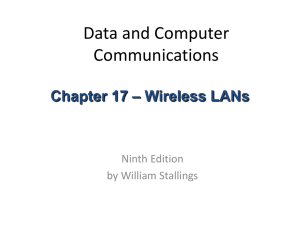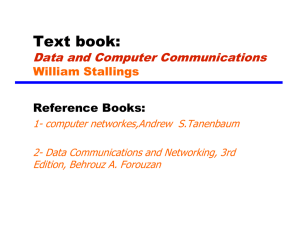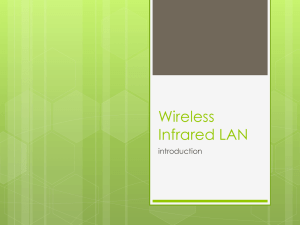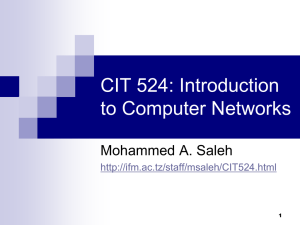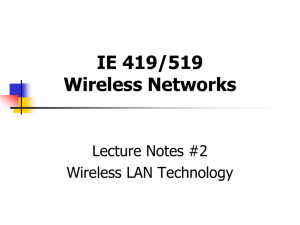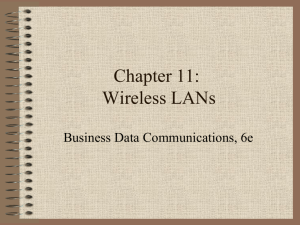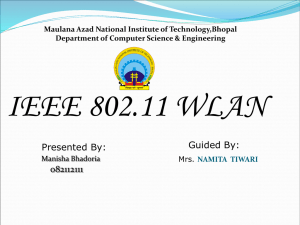Faculty of Computer Science & Engineering
advertisement
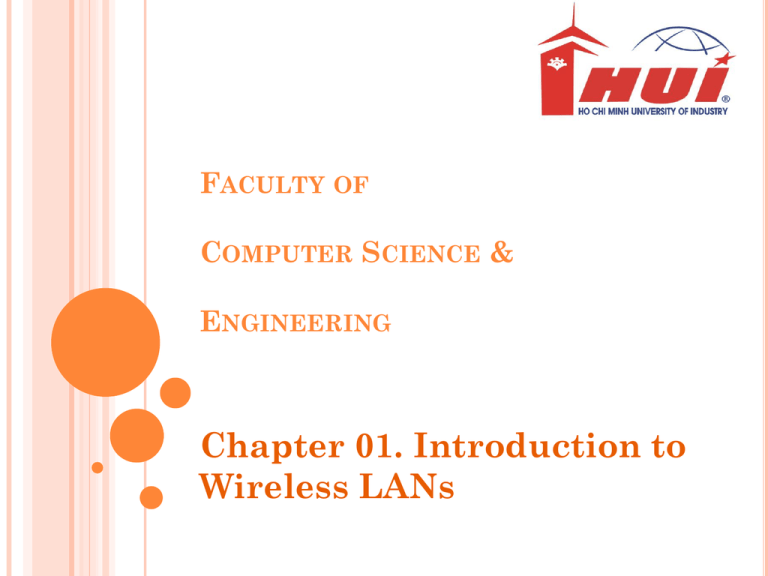
FACULTY OF COMPUTER SCIENCE & ENGINEERING Chapter 01. Introduction to Wireless LANs QUESTION 1 Which one of the following does a wireless LAN provide that a wired network does not? a) Mobility b) Centralized security c) Reliability d) VPN security QUESTION 2 2. Which one of the following would not be an appropriate use of a wireless LAN? A. Connecting two buildings together that are on opposite sides of the street B. Connecting two computers together in a small office so they can share a printer C. Connecting a remote home to a WISP for Internet access D. Connecting two rack-mounted computers together QUESTION 3 3. Why is a wireless LAN a good choice for extending a network? Choose all that apply. A. Reduces the cost of cables required for installation B. Can be installed faster than a wired network C. The hardware is considerably less expensive D. Eliminates a significant portion of the labor charges for installation QUESTION 4 4. Wireless ISPs provide which one of the following services? A. Small office/home office services B. Connectivity for large enterprises C. Last mile data delivery D. Building-to-building connectivity QUESTION 5 5. Wireless LANs are primarily deployed in which one of the following roles? A. Backbone B. Access C. Application D. Core QUESTION 6 6. Why would a mobile office be a good choice for using a wireless LAN? Choose all that apply. A. It would take less time to setup than wiring a network B. The equipment could be removed easily if the office moves C. It would not require any administration D. It is a more centralized approach QUESTION 7 7. Which one of the following is the IEEE family of standards for wireless LANs? A. 802.3 B. 803.5 C. 802.11 D. 802.1x QUESTION 8 8. As a consultant, you have taken a job creating a wireless LAN for an office complex that will connect 5 buildings in close vicinity together. Given only this information, which one of the following wireless LAN implementations would be most appropriate for this scenario? A. Last-mile data service from a WISP B. Point-to-point bridge links between all buildings C. Point-to-multipoint bridge link from a central building to all remote buildings D. One central antenna at the main building only QUESTION 9 9. Which of the following are challenges that WISPs face that telephone companies and cable companies do not? Choose all that apply. A. Customers located more than 18,000 feet from a central office B. High costs of installing telephone lines or copper cabling C. Trees as line of sight obstructions D. Rooftop access for antenna installation QUESTION 10 10. In what organization did the use of spread spectrum wireless data transfer originate? A. WECA B. WLANA C. FCC D. U.S. Military QUESTION 11 11. Which one of the following is the most recently approved IEEE standard for wireless LANs? A. 802.11a B. 802.11b C. 802.11c D. 802.11g QUESTION 12 12. Which one of the following IEEE standards for wireless LANs is not compatible with the standard currently known as Wi-Fi™? A. 802.11 B. 802.11g C. 802.11a D. 802.11b QUESTION 13. Which one of the following IEEE 802.11 standards for wireless LANs utilizes the 5GHz UNII bands for its radio signal transmissions? A. 802.11b B. Bluetooth C. 802.11 D. 802.11g E. 802.11a QUESTION 14 14. A WISP would take advantage of which one of the following applications for wireless LANs? A. Last Mile data delivery B. Building-to-building bridging C. Classroom connectivity D. Home network connectivity QUESTION 15 15. Who makes the laws that govern the usage of wireless LANs in the United States? A. IEEE B. WECA C. FCC D. FAA
